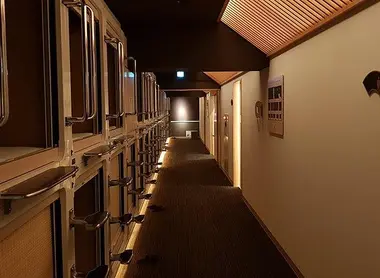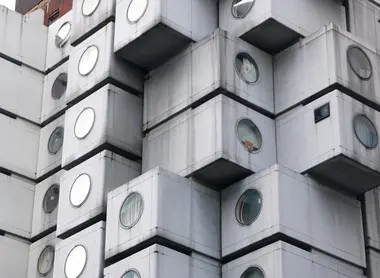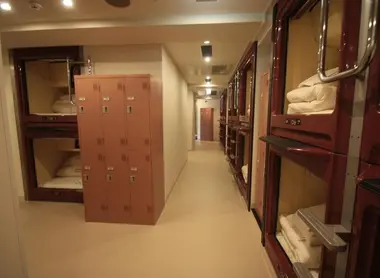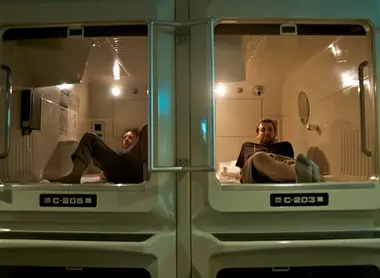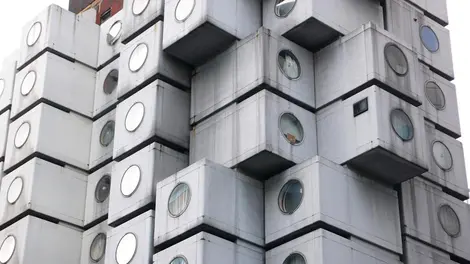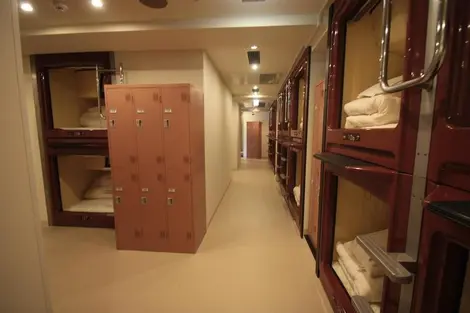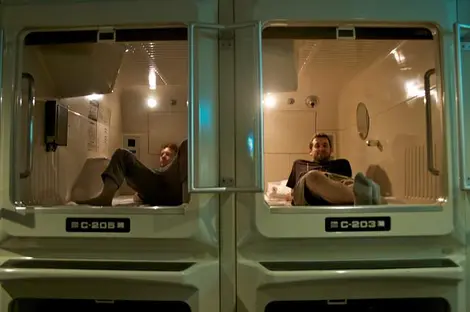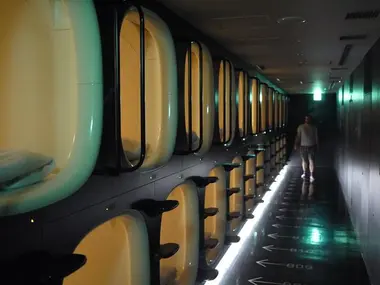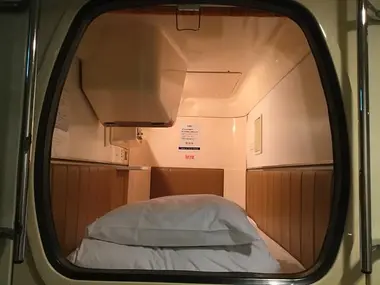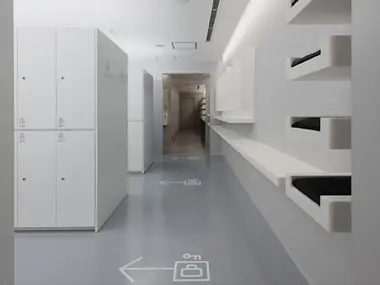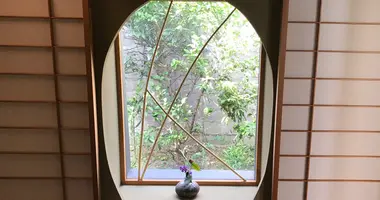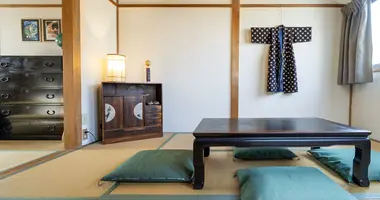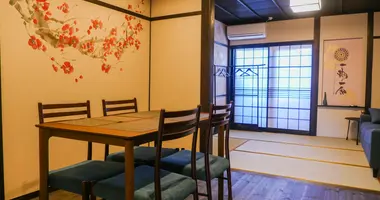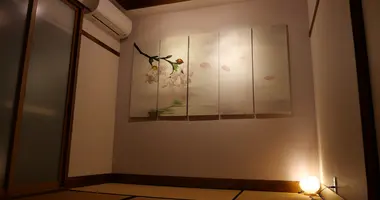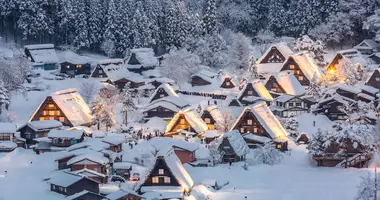Capsule hotels in Japan
- Published on : 20/09/2019
- by : R.A. / J.R.
- Youtube
Unusual experience in Japan: sleeping in a cabin
Capsule hotels are a typically Japanese form of accommodation, born in Osaka in the 1970s. Invented by architect Kisho Kurokawa, these establishments are characterized by their minimalist concept: rooms reduced to simple stacked cabins, offering just the space needed to sleep. Initially designed for salarymen who missed their last train, they now attract many tourists curious to live this unique experience. Combining functionality and space optimization, capsule hotels are the perfect embodiment of this Japanese philosophy, where every square centimeter is used efficiently.
What is a capsule hotel? Origin and concept
The concept of capsule hotels (カプセルホテル, kapuseru hoteru) originated in Japan, as a result of thinking about the optimization of urban space. The first establishment of its kind, the Capsule Inn Osaka, opened its doors on February 1, 1979 in the Umeda district of Osaka. Created by architect Kisho Kurokawa, a figure of the Metabolist movement, the project followed the Osaka World Expo and was part of the search for economical and functional accommodation solutions.
The basic idea was simple: to offer a minimal amount of private space, but enough to satisfy the essential need for sleep. Initially, these hotels catered mainly to Japanese businessmen who had missed their last train or left their meetings too late to return home. Over time, capsule hotels spread throughout Japan's major cities, evolving to also attract tourists in search of authentic, cost-effective experiences.
Since their inception, these establishments have grown in popularity to the point of being exported beyond Japan's borders. Capsule hotels can now be found in China (since 2012), Europe and even the United States, testifying to the worldwide interest in this minimalist, functional accommodation concept.
Capsule configuration and features
The configuration of capsule hotels is truly unique. Each capsule, usually made of plastic or fiberglass, measures around 2 meters long, 1 meter wide and 1.25 meters high. These dimensions are calculated to provide just enough space for a person to lie down comfortably and sit in their capsule. Space is optimized to the maximum, perfectly illustrating Japanese ingenuity in making the most of every available centimeter.
Inside, each capsule is generally equipped with a futon or comfortable mattress, a small TV, reading lamp, radio, alarm clock and individual air-conditioning. An increasing number of establishments also offer an electrical outlet and Wi-Fi connection to meet the needs of modern travelers. For security reasons, capsules are not fitted with lockable doors, but rather with curtains or blinds to ensure relative privacy.
These cabins are generally arranged in rows and stacked on two levels, with ladder access to the upper capsules. This layout enables a large number of customers to be accommodated in a relatively small space. Establishments vary considerably in size: some offer as few as 50 capsules, while the largest can boast over 700, testifying to the growing popularity of this type of accommodation.
Services and amenities
Despite their minimalist appearance, capsule hotels generally offer a full range of services and amenities to ensure their guests' comfort. One of the most distinctive features is the presence of communal washrooms, often inspired by sento (Japanese public baths). These spaces, always impeccably clean, include showers, toilets and sometimes even communal baths or saunas, offering a truly relaxing experience after a day of sightseeing or work.
To compensate for limited capsule space, most establishments offer secure lockers where guests can store their luggage. On arrival, each guest receives a number corresponding to his or her capsule and locker. Some hotels also provide a yukata (light kimono) and slippers, reminiscent of the services offered in traditional ryokans.
Communal areas are also designed with guest comfort in mind. There are often lounges with TVs, vending machines offering drinks and snacks, and sometimes even restaurants or cafeterias. More modern capsule hotels sometimes offer additional amenities such as gyms, coworking spaces or libraries, like Book and Bed establishments where you can sleep surrounded by books.
Some chains, such as Nine Hours, have taken the concept a step further, offering packages where you can rent a capsule just to take a nap during the day, an option particularly appreciated by travelers in transit or those needing to rest between appointments.
Price and accessibility: an economical option for travelers
One of the main attractions of capsule hotels is their affordability. On average, a night costs between 2,000 and 7,000 yen (around 16 to 58 euros), making them a much more economical option than traditional hotels in major Japanese cities. This affordability largely explains their popularity with both Japanese business travellers and foreign tourists on a budget.
In terms of geographical accessibility, capsule hotels are generally located in strategic areas, close to train stations, business districts or busy tourist areas. This privileged location enables customers to get around easily and reach the main points of interest quickly, a significant advantage for travelers in a hurry or those who have missed their last train.
There are now different ranges of capsule hotels, from basic establishments to more luxurious concepts such as First Cabin, which takes its inspiration from first-class aircraft cabins. The latter offer more spacious capsules and premium services, at generally higher rates (between 7,000 and 10,000 yen per night).
Reservations, once impossible, have become considerably simpler with the growth of international tourism. Many establishments now offer online reservations via their own websites or international platforms such as Booking.com, making these accommodations even more accessible to foreign travelers.
Specific clientele and rules (separation of men and women)
Traditionally, capsule hotels were mainly frequented by salarymen and were therefore often reserved exclusively for men. This typical clientele was made up of workers who had missed their last train after a long evening's work or a night out with colleagues, or who were simply looking for economical accommodation during a business trip.
Today, with changing attitudes and the growth of international tourism, many capsule hotels have adapted to accommodate a more diverse clientele. Many establishments now offer separate floors or sections for men and women, with secure access to guarantee privacy and tranquility for all. This separation is essential in this type of accommodation, where spaces are shared and promiscuity could be a source of discomfort.
Some hotels have even become exclusively feminine, such as the Nadeshiko Hotel in Shibuya or the Bay Akihabara, responding to a growing demand from solo female travelers. These establishments often emphasize security and offer services specifically designed for their female clientele.
It should be noted that capsule hotels are generally not suitable for families with children (under-12s are often not admitted), nor for couples wishing to share the same space, since capsules are individual and male/female separation is generally strict. For these travelers, other options such as renting a house with Japan Experience will be more appropriate. Discover all our houses here!
The best capsule hotels to discover in Japan
Japan offers a multitude of capsule hotels, each with its own particularities. Here's a selection of the most remarkable establishments for this unique experience:
Nine Hours has become a benchmark for capsule hotels in Japan. Present at Narita airport, Tokyo and Kyoto, the chain offers a futuristic, uncluttered experience. The concept is based on a simple formula: 1 hour to shower, 7 hours to sleep and 1 hour to get ready, for a total of 9 hours. The capsules are immaculately white, the design minimalist and the facilities modern and clean. An excellent choice for a first experience.
First Cabin reinvents the concept of the capsule hotel, drawing inspiration from first-class airplane cabins. Their establishments offer more spacious capsules, classified into different categories (first class, business class, etc.). The "first class" capsules even allow you to stand up, offering extra comfort for those who might be claustrophobic.
For an original experience, Book and Bed offers the chance to sleep among books. This hybrid concept between library and capsule hotel lets guests fall asleep reading, surrounded by thousands of books. An experience particularly appreciated by book lovers.
Near airports, you'll also find establishments like the Capsule Hotel 9h Narita Airport, ideal for travelers in transit or with early-morning flights. These hotels generally offer hourly rates, so you can relax without booking a full night's stay.
In Tokyo's Shinjuku district, the Capsule Hotel Anshin Oyado offers a more luxurious experience, with a large public bath, sauna and massages. It's an excellent choice for those wishing to combine the capsule hotel experience with a moment of relaxation.
Practical tips for your first capsule hotel experience
To make your first capsule hotel experience a success, here are a few practical tips to keep in mind:
Travel light or plan to leave bulky luggage in a locker. Space in capsule hotels is limited and generally reserved for your body and a few essential personal belongings. Most capsule hotels provide lockers, but these may be too small for large suitcases.
Be prepared for a lack of privacy. Although each capsule offers a private visual space, noise travels easily. Remember to bring earplugs if you're a light sleeper, as you may be able to hear your neighbors snoring or making noise.
Respect the rules of the establishment, especially as regards opening hours. Many capsule hotels impose a daily check-out, even for multi-night stays, in order to clean the capsules. Some may also have a curfew or restrictions on night-time entry and exit.
Familiarize yourself with Japanese bathing etiquette if your hotel has sento-type facilities. Important reminder: wash thoroughly before entering the communal bath, and don't bring towels.
For a more comfortable experience, book in advance, especially during busy tourist periods or weekdays in business districts. If you're planning a longer stay in Japan, consider alternating between different types of accommodation for a more complete experience, such as a Ryokan, the quintessential Japanese art of living, or discover What's the difference between ryokan and minshuku?
With its unique features, the capsule hotel is much more than just a place to sleep: it's an authentic immersion in modern Japanese culture. To explore Tokyo in its entirety, discover many different types of accommodation in "Tokyo, the Ideal Guide" and complete your search with our complete guide to Accommodation in Japan and our feature on Unusual accommodation in Japan.
Between tradition and modernity, economy and functionality, capsule hotels represent an unmissable experience during a stay in Japan, offering travelers a unique way to immerse themselves in the culture of space optimization so characteristic of the Land of the Rising Sun.
Nos maisons cozy, en solo ou en couple
Address, timetable & access
Address
Price
Between 2,000 and 7,000 yen per night (€16 to €58)
